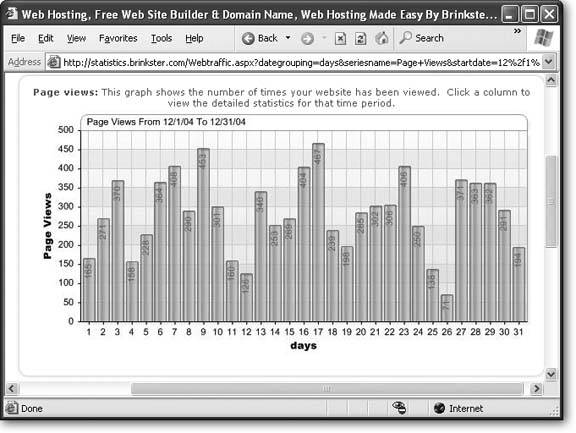Section 11.5. Tracking Visitors
11.5. Tracking VisitorsAs a Web site owner, you'll try a lot of different tactics to promote your site. Naturally, some will work while others won'tand you'll need to keep the good strategies and prune those that fail. In order to do this successfully, you need a way to assess how your Web site is performing. Almost every Web hosting company (except for those that don't charge a fee) give you some way to track the number of visitors to your site (see Figure 11-10). Ask your Web hosting company how to use these tools. Usually, you need to log on to a "control panel" or "my account" section of your Web host's site. You'll see a variety of options therelook for an icon labeled "site counters" or "Web traffic."
11.5.1. Web Server LogsWith more high-end hosting services, you often have more options for viewing your site's traffic statistics. For example, you might be able to get a report by time of day, or get an indication of how many pages each visitor is reading. But to get really detailed information, you need to grab the raw Web server logs . Many commercial Web hosts provide the server logs, but you may need to ask their technical support department how you can download them. The Web server logs are important because they have detailed, blow-by-blow information about every visitor. This information includes the time visitors came, their IP addresses (Section 3.1.2), their browsers, what site referred them to you, whether they ran into an error, what pages they ignored, what pages they loved, and so on. The information in a Web server log is richer by several orders of magnitude than the simple Web traffic analysis offered by your Web host. You won't be able to interpret a server log on your own, but you can feed it into a log analysis program for more detailed breakdowns. For example, you can use a log analyzer to pick out your most popular pages, the sites that are leading visitors to you, and what browsers and operating systems your fans use. This information can help you tailor your Web site and your promotional tactics. Log analyzers are notoriously complex, but you can get a good overview of a few free choices from www.thefreecountry.com/webmaster/loganalyzers.shtml. 11.5.2. Hit CountersThe best choice is to work with a dedicated analysis program and review the raw server logs. However, this isn't an option for everyone. Low-priced Web hosts might not make the server logs available. In fact, free Web hosts probably won't even give you a single tool for traffic analysis. In this case, you may want to use a free hit counter service from another company. A hit counter is a page element that counts up the number of times your page has been requested . The appearance of a hit counter variessome hit counters show the number of hits directly on the page (usually with a small picture), while others are invisible and collect their data silently for later analysis. Here's how a typical hit counter service works:
|
EAN: N/A
Pages: 135
